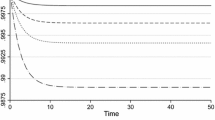Abstract
This paper assesses empirically the relative desirability of alternative deficit-reducing tax increases and expenditure cuts in terms of their individual impact on economic growth, using cross-sectional data for a sample of 21 developed countries for the period 1972–81.
Property taxes are by far superior to deficit financing, and are the best choice for implementing deficit-reducing tax increases. Income taxes and domestic taxes on goods and services, which are as bad for growth as are deficits, rank second with no difference between them. Foreign trade taxes are even worse for growth than are deficits, and are the worst choice for reducing deficits.
Classifying government expenditures into capital and current expenditures renders the latter as the best type for implementing a reduction in expenditures. Deficit-reducing cuts in capital expenditures are concomittant with lower growth, while such cuts in current expenditures have no net impact on growth.
Similar content being viewed by others
References
Landau, O. (1983). Government expenditures and economic growth: A cross-country study. Southern Economic Journal 49: 783–792.
Landau, O. (1985). Government expenditures and economic growth in the developed countries: 1952–1976. Public Choice 47(3): 459–476.
Marlow, M.L. (1986). Private sector shrinkage and the growth of industrialized economies. Public Choice 49: 143–154.
Marlow, M.L. (1988). Private sector shrinkage and the growth of industrialized economies: Reply. Public Choice 58: 285–294.
Marsden, K. (1983). Link between taxes and economic growth: Some empirical evidence. World Bank Staff Working Papers, No. 605, D.C.
Martin, R. and Fardmanesh, M. (1990). Fiscal variables and growth: A cross-sectional analysis. Public Choice 64(3): 239–251.
Saunders, S. (1986). What can we learn from international comparison of public sector size and economic performance? European Sociological Review 2: 52–60.
Ram, R. (1986). Government size and economic growth: A new framework and evidence from cross-section and time-series data. American Economic Review 76(1): 191–203.
Author information
Authors and Affiliations
Additional information
I am indebted to Ricardo Martin and Joey Dayao for their help.
Rights and permissions
About this article
Cite this article
Fardmanesh, M. Economic growth and alternative deficit-reducing tax increases and expenditure cuts: A cross-sectional study. Public Choice 69, 223–231 (1991). https://doi.org/10.1007/BF00123849
Received:
Accepted:
Issue Date:
DOI: https://doi.org/10.1007/BF00123849



